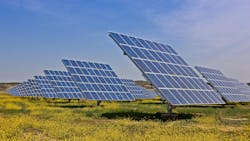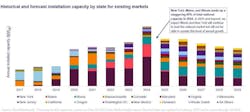Record-Breaking 1.7 GW of U.S. Community Solar Installed in 2024
The U.S. community solar market installed a record-breaking 1.7 GWdc of capacity in 2024, a 35% increase from 2023, according to a new report released by Wood Mackenzie in collaboration with the Coalition for Community Solar Access (CCSA). However, with policy uncertainty at both national and state levels, long-term growth hangs in the balance.
According to the report, last year’s growth was led by New York, Maine, and Illinois. All three states broke annual records and accounted for 83% of national volumes. Cumulative community solar installations now total 8.6 GWdc.
“We saw impressive activity in 2024, resulting in our strongest year yet for community solar growth,” said Caitlin Connelly, research analyst and lead author of the report.
“However, despite impressive 2024 installation volumes, the top state markets are saturating quickly and will not be able to sustain the same levels of growth long-term. Additionally, emerging markets have been slow to ramp up and program size caps limit the potential for growth in these states to make up for declines in larger markets.”
As a result, in Wood Mackenzie’s base case, national community solar growth will contract 8% annually on average through 2029, culminating in more than 15 GWdc of cumulative community solar installed. However, depending on how policy changes and interconnection reform materialize, the growth outlook could vary greatly.
Potential new state markets
An area of boost could come from new state markets that have proposed legislation for community solar programs. In the last year, legislation in Pennsylvania, Ohio, Missouri, Iowa, Georgia, Washington, and Wisconsin has progressed further than ever before, signaling strong bipartisan support and the potential for new market expansion. Community solar is also being incorporated into major state energy plans, such as Pennsylvania’s Lightning Energy Plan, reinforcing its value to lawmakers and regulators. If all comes to pass, new community solar state markets have the potential to boost base case outlook by at least 16% by 2029.
LMI customers could expand
Community solar capacity directly serving low-to-moderate income (LMI) subscribers is concentrated in New York and Massachusetts. The two states combined comprise 49% of the 1 GWdc of LMI-serving community solar, highlighting the continued reliance on state and federal incentives to boost LMI capacity. In total, LMI subscribers make up 14% of total deployed community solar capacity.
Stricter LMI subscriber requirements in emerging state markets will result in LMI capacity making up nearly 18% of total community solar capacity by 2026. Federal uncertainty regarding the LMI Communities adder and Solar for All funding could potentially limit the long-term growth of LMI capacity.
Developer and asset owner leaderboards remain highly consolidated
The top five community solar installers secured 19% of the market in 2024, down from 25% in 2023. The competitive landscape for asset owners is significantly more exclusive, dominant, and region-specific than that of community solar installers. The top 10 community solar asset owners secured 54% of capacity installed in 2024 and 40% of cumulative capacity. Top asset owners include Nexamp, AES Clean Energy, and Nautilus Solar.
Notes:
Community solar refers to local solar facilities shared by multiple community subscribers that receive credits on their electricity bills for their share of the energy produced. In most cases, customers subscribe to community solar projects and receive a bill credit from the utility. The size of the bill credit is determined by the program. Programs can provide a full retail-rate bill credit or some alternative rate.
Community solar has a diverse customer base. Homeowners, renters, and apartment tenants unable to install rooftop solar are typical subscribers to community solar systems. Additionally, non-residential entities like commercial and industrial companies, non-profits, or municipal and government entities often serve as “anchor tenants.” An anchor tenant signs a longer-term contract for offtake from the project and tends to use a significant amount of the electricity supplied by the project.

